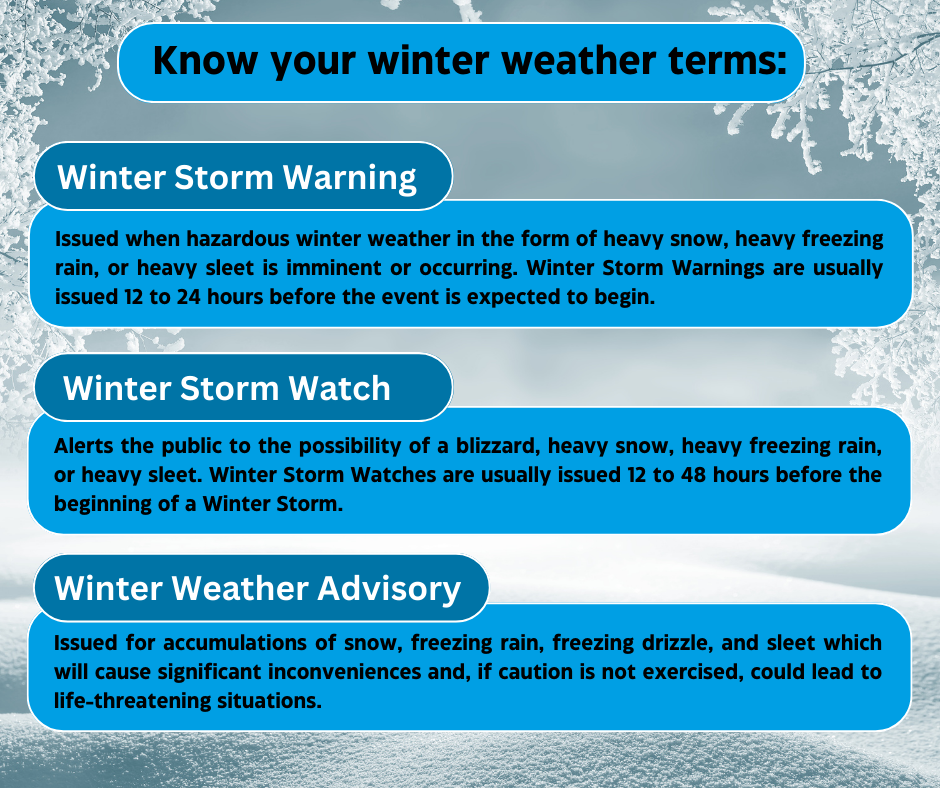A Practical Winter Weather Timeline For Home And Business

Table of Contents
Early Fall (September - October): Pre-Winter Preparations
Before the first snowflakes fall, taking preventative measures is key to successful winter weather preparedness. This proactive approach minimizes risks and saves you time and money in the long run.
Home Preparations: Your Home Winterization Checklist
A thorough home inspection is your first line of defense. Use this home winterization checklist to get started:
- Inspect and clean gutters: Clogged gutters can lead to ice dams and roof damage. Clear out leaves and debris to ensure proper water drainage.
- Check and repair roof leaks: Address any leaks promptly to prevent water damage from freezing temperatures. A small leak now can become a major problem later.
- Winterize outdoor faucets: Protect your pipes from freezing by disconnecting hoses and draining outdoor faucets. Consider installing faucet covers for added protection.
- Stock up on firewood: If you rely on a wood-burning stove or fireplace, ensure you have an ample supply of seasoned firewood.
- Purchase snow shovels and ice melt: Having the right tools readily available saves valuable time and effort during a snowstorm. Choose a shovel appropriate for your physical capabilities and consider using eco-friendly ice melt.
- Test smoke and carbon monoxide detectors: Ensure your detectors are functioning correctly and replace batteries if needed. These are crucial for home safety year-round, but especially during winter.
- Service heating systems (furnace, boiler): Schedule a professional inspection and tune-up of your heating system to ensure it's running efficiently and safely. This preventative maintenance can prevent costly breakdowns during the coldest months.
Business Preparations: Your Business Winter Weather Plan
For businesses, winter weather preparedness is not just about comfort; it's about maintaining operations and protecting your assets. A comprehensive plan is essential:
- Inspect building exterior for potential issues: Check for cracks in the walls, damaged roofing, and issues with windows and doors that could let in cold air or snow.
- Check heating systems: Ensure your heating systems are in top working order to prevent disruptions to your business operations. Schedule maintenance and repairs as needed.
- Stock up on emergency supplies: Prepare a kit including flashlights, batteries, first-aid supplies, and non-perishable food and water for employees.
- Create a winter weather emergency plan: Develop a detailed plan outlining procedures for different weather scenarios, including communication protocols, employee safety measures, and business continuity strategies.
- Communicate the plan to employees: Ensure everyone understands their roles and responsibilities during a winter storm. Conduct regular training and drills to reinforce the plan.
- Schedule preventative maintenance on essential equipment: Preventative maintenance for critical equipment is essential for business continuity. This includes backup generators, HVAC systems, and other essential machinery.
Late Fall (November): Refining Your Winter Weather Plan
November is the time to fine-tune your preparations and ensure you’re ready for anything.
Home Refinements: Your Winter Storm Supplies Checklist
Your winter storm supplies checklist should be comprehensive and readily accessible:
- Stock up on non-perishable food and water: Aim for enough supplies to last for at least three days per person. Consider dietary needs and preferences.
- Assemble a winter emergency kit: Include flashlights, extra batteries, blankets, a first-aid kit, medications, and any other essentials.
- Update contact information for emergency services: Keep a readily accessible list of emergency contact numbers.
- Plan alternate routes in case of road closures: Identify alternative routes to work, school, or essential services in case of road closures.
Business Refinements: Your Winter Business Emergency Plan
Refining your winter business emergency plan in November ensures you're prepared for the worst:
- Finalize communication protocols for employees: Establish clear communication channels to ensure employees can be reached quickly during a storm.
- Arrange for snow removal services: Secure contracts with snow removal services well in advance to avoid delays.
- Identify backup power sources: Ensure you have backup power sources to keep critical systems running during a power outage.
- Test emergency systems (alarms, generators): Test all emergency systems to ensure they are functioning correctly. This includes fire alarms, generators, and other safety systems.
- Ensure adequate insurance coverage: Review your insurance policies to ensure you have adequate coverage in case of weather-related damage or business interruption.
Winter (December - February): Monitoring and Responding to Winter Weather
Once winter hits, consistent monitoring and swift responses are critical.
Home Response: Winter Storm Safety Tips
Staying safe during winter storms requires vigilance:
- Monitor weather forecasts regularly: Stay informed about approaching storms and potential hazards.
- Prepare for potential power outages: Have flashlights, batteries, and a plan for warmth readily available.
- Stay informed about road conditions: Avoid unnecessary travel during severe weather and check road conditions before heading out.
- Avoid unnecessary travel during severe weather: Stay home unless absolutely necessary during severe winter storms.
- Know how to safely operate backup generators: If you have a generator, ensure you know how to use it safely and follow all manufacturer instructions.
Business Response: Winter Weather Business Continuity
Effective responses are key to winter weather business continuity:
- Implement your winter weather emergency plan: Follow your pre-established plan to ensure a coordinated and effective response.
- Communicate with employees and customers: Keep everyone informed about potential disruptions and safety measures.
- Monitor weather conditions and adjust operations as needed: Be flexible and adapt your operations to changing weather conditions.
- Ensure the safety of employees and customers: Prioritize the safety and well-being of everyone involved.
- Keep a record of any weather-related incidents: Maintain accurate records of any incidents for insurance purposes and future planning.
Conclusion
Successfully navigating winter weather requires proactive planning and preparation. By following this practical winter weather preparedness timeline, both homeowners and businesses can significantly reduce risks and disruptions. Remember that thorough winter weather preparedness is essential for safeguarding your property, protecting your assets, and ensuring the well-being of everyone involved. Don’t wait until the first snowflake falls—start planning your winter weather preparedness strategy today!

Featured Posts
-
 Canberra Marathon Bob Fickel Runs His 40th Race
Apr 25, 2025
Canberra Marathon Bob Fickel Runs His 40th Race
Apr 25, 2025 -
 April 1945 A Month Of Pivotal World Events
Apr 25, 2025
April 1945 A Month Of Pivotal World Events
Apr 25, 2025 -
 Scale The Strat 2025 Exceeds Fundraising Goal For American Lung Association
Apr 25, 2025
Scale The Strat 2025 Exceeds Fundraising Goal For American Lung Association
Apr 25, 2025 -
 Bof As View Understanding And Addressing Elevated Stock Market Valuations
Apr 25, 2025
Bof As View Understanding And Addressing Elevated Stock Market Valuations
Apr 25, 2025 -
 Plan Your Spring Break Oklahoma City Park Activities
Apr 25, 2025
Plan Your Spring Break Oklahoma City Park Activities
Apr 25, 2025
